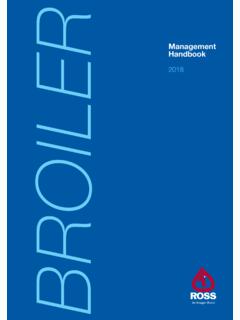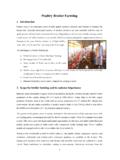Transcription of BROILER - Aviagen
1 BROILERROSS TECHL ighting for broilers 2010201002 Lighting for broilers : About the AuthorsKAREN SCHWEAN-LARDNER - Born and raised in Saskatchewan, Canada, Karen completed her Master of Science work at the University of Sas-katchewan, where she helped design, build and test for welfare and productivity, an early stage of the furnished cage for laying hens. Since finishing her master s degree, Karen has been employed by the Poultry Research Unit at the University of Saskatchewan. Karen is currently the manager of the poultry teaching and research unit which encompasses a BROILER facility, commercial turkey facility, laying hen unit and a small hatchery.
2 She is completing her doctorate in poultry welfare and management, working on the effects of darkness exposure on the welfare and productivity of commercial broilers . Karen s interests are in poultry welfare, behavior and management HANK CLASSEN - Hank Classen was born and raised in rural Saskatchewan, Canada. He re-ceived his undergraduate degree at the University of Saskatchewan and then completed master s and doctorate degrees at the University of Mas-sachusetts in the United States. After a brief stay on faculty at The Pennsylvania State University, he returned to the Department of Animal and Poultry Science at the University of Saskatchewan where he is currently professor and department Classen s teaching and research responsibilities are primarily in the areas of poultry nutrition and management.
3 His nutritional research has focused on feed ingredients and feeding programs for broilers and laying hens. Manage-ment research has emphasized animal welfare issues including the impact of light ( broilers ), beak trimming (laying hens), nutritional manipulation of behavior (laying hens, BROILER breeders) and transportation ( broilers ).As a result of his research and interaction with the industry, he has received the Award for Distinction in Outreach and Engagement (2008), the designation as Fellow of the Poultry Science Association (2007), the Award of Innovation (2004), the Alberta Poultry Serviceman of the Year (1994) and the American Feed Industry Association Nutrition Research Award (1993).
4 Dr. Classen has served as president of the World s Poultry Science Association - Canada Branch and the Poultry Science Association as well as serving as a director for both organizations. 201003 Lighting for broilers : SummaryThe key points are: The response to daylength does not differ between strains or sexes. BROILER performance is not optimized by providing 23 hours of light and this lighting program is not recommended. Providing broilers with 23 hours of light has a negative effect on - growth rate - feed intake - mortality - processing performance - BROILER welfare BROILER performance and welfare are optimized when between 17 and 20 hours of light are given.
5 SUMMARYT raditionally, it has been assumed that using long daylengths for broilers will maximize growth rate. However, recent research examining the relationship between daylength and a range of characteristics in commercial broilers has shown that this is not always correct. This document gives updated information on the response of broilers (production, meat yield and welfare parameters) to Note: The following abbreviation applies to this document. L = Hours of Light201004 Lighting for broilers : IntroductionINTRODUCTIONL ight is an important management technique in BROILER production and is composed of at least three aspects, light wavelength, light intensity and photoperiod length and distribution.
6 The latter aspects can be considered independently but are known to have interactive effects. By far the most research on BROILER lighting has been devoted to the impact of photoperiod length and distribution. Traditionally, it has been assumed that using long daylengths in management schemes allowed maximum feeding time and, as a consequence, maximum growth rate. A joint research program between Aviagen and the University of Saskatchewan examined the relationship between darkness exposure and a range of characteristics in commercial broilers . The documents associated with this research will describe the impact of 14 (14L), 17 (17L), 20 (20L) and 23 (23L) hours of light per day with all darkness provided in one period on BROILER production and meat yield parameters, welfare and bird health.
7 MATERIALS AND METHODSFour trials were conducted to study the effect of daylength, BROILER sex and strain and their interactions on production parameters in broilers . Table 1 summarizes the final ages and stocking densities used in the trials. A total of just over 16,000 broilers were included in these trials. Two strains were tested (Ross x Ross 308 and Ross x Ross 708) in each trial and sexes were housed separately. Statistical analysis failed to demonstrate major strain by lighting program or strain by sex interactions on traits measured. The lack of interactions indicates that the two strains and sexes react similarly to lighting changes and therefore, this report focuses primarily on lighting 1: Experimental i a l NumberTo t a l B i r d NumbersSlaughter AgeMaximum Final Stocking Density1504031 or 39 days24 kg/m2 2446439 or 49 days30 kg/m23371239 days30 kg/m24291248 days30 kg/m2 Lighting program treatments consisted of graded amounts of daylength to allow the description of relationships between daylength and particular production traits.
8 The lighting treatments were 14 (14L), 17 (17L), 20 (20L) and 23 (23L) hours of light per day with all darkness provided in one period. All birds were exposed to 23L with 20 lux (2 foot candles[fc]) light intensity until 7 days of age when they were placed on experimental lighting treatments. The light intensity was reduced to 8 lux ( fc) at the same time. Light intensity was measured at bird height at the center of the middle pen within each room on the day of chick placement and again at the initiation of lighting programs at 7 days of age. Experimental rooms had light traps on fans and inlets to eliminate light entry.
9 The light source was incandescent research was completed in eight environmentally independent rooms each subdivided into 12 pens (6 pens of males (53 males per pen) and 6 pens of females (63 females per pen)) and environmental conditions were similar to commercial settings. Each lighting program was replicated in two rooms in each trial. The BROILER chicks were hatched in a commercial hatchery. Wheat straw was used as litter material in cleaned and disinfected pens in trials 1 and 2, while reused wheat straw based litter was used in trials 3 (reused 2 times) and 4 (reused 3 times).
10 Room temperature followed standard industry practice with a gradual reduction from brooding temperatures to 22oC (72oF). Feed (1 tube feeder per pen; 0 to 24 days 110 cm (44 inch) circumference; 24 days to market cm (55 inch) circumference) and water (Lubing 4087 nipple drinkers with 6 nipples per pen) were 201005 Lighting for broilers : Materials and Methodsprovided on an ad libitum basis. Feed allocation was based on the number of birds placed and provided kg ( lb) Starter (crumbled form), 2 kg ( lb) Grower (crumble) and the balance of feed as Finisher 1 (pellet). For birds grown to 49 days of age, kg ( lb) of Finisher 1 was fed, and Finisher 2 was subsequently fed until the end of the trial.













